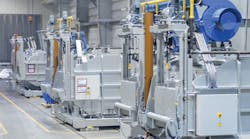Melting iron or steel or aluminum takes a lot of planning, starting with the metalcaster’s selection of a melting system. A lot of factors go into that decision, many of them entirely specific to the particular operation – but for each of them, energy-savings is a factor of increasing importance.
Ludwig Frischhut GmbH, a gray and ductile iron foundry, recently ordered two new MonoMelt induction furnaces from Otto Junker GmbH. The 5-mt, medium-frequency furnaces will replace two line-frequency coreless induction furnaces, in large part so that the foundry will be able to run both furnaces simultaneously without the restrictions imposed by the electric grid.
The two furnaces (fitted with extraction hoods, charging and weighing systems) will be powered by a 3,200-kW IGBT frequency converter with a high-voltage transformer.
In addition to the flexibility to be gained by operating two furnaces at the same time, Frischhut will be able run them independently, stopping one operation without disrupting the other. Each of the new furnaces’ transformers have been designed to minimize the system load (i.e., transformer phase shifting), and multi-frequency capability will optimize carburizing or alloying stages by switching the frequency from 250 to 125 Hz. According to Junker, this step conserves energy while intensifying bath movement and thus accelerating the induction-stirring phase. This will mean higher melting output than the previous furnaces.
Among other energy-saving advantages, Junker noted the foundry would be able to start melting without a heel, another factor lowering overall energy consumption.
Energy conservation is not limited to induction melting. Another furnace developer, Fomet Srl, has extended the initiative into the pour phase. Noting an increasing demand for ductile iron melting systems, Fomet developed a new system for melting and pouring iron alloys.
The new furnace is a bottom-pouring induction heated furnace that can be emptied easily to change grades as needed, and can be turned off during idle periods to save power, and then easily restarted.
An efficient refractory lining was developed to minimize the thermal losses, contributing to overall energy savings. The system requires only a comparatively small power input to melt, hold, and superheat the metal, and it’s also easy to control metal temperature to promote a longer refractory lining life.
The new pouring furnace can be equipped with various pouring options available from Fomet, like the CCD Vision system to control the mold cup filling level; late metal stream inoculation; furnace weighing; and an automatic skip charger for the furnace charging ladle.
Fomet notes several notable automotive foundries in the EU have selected the new pouring furnace.
Elsewhere in the world, China to be specific, energy-conservation is more than a cost consideration. It can be a regulatory requirement. The Chinese government has instituted various regulations to reduce air pollution, affecting innumerable industrial operations. In fact, with the latest round of regulatory measures, energy-intensive operations like aluminum foundries will be subjected to closer inspection to ensure compliance with energy-conservation, environmental, and safety standards. Operations that do not meet the standards may be forced to close.
The Chinese Foundry Association (FICMES) estimated that about 10,000 foundries in the country may expect to be sanctioned by government inspectors, and some may be threatened with closure. But, the regulatory codes are not the only factors pressuring China’s metalcasters. Outdated systems with high rates of metal losses make it increasingly difficult for foundries to remain competitive.
According to StrikoWestofen, a reverb furnace developer, demand for its various aluminum melting and pouring furnaces is rising among Chinese metalcasters. It claims that the StrikoMelters installed in China since 2009 have reduced metal losses by the equivalent of 19,700 mt/year, while reducing energy consumption by 30.4 million cubic meters of natural gas.
The savings in CO2 emissions are equally impressive. The StrikoMelters in place now represent carbon dioxide emissions reductions of about 60,800 tons of CO2 per year compared to the more standard aluminum melting technologies. That would be the equivalent of CO2 emissions from about 38,000 passenger cars.
The foundry operators are saving production costs, too: at an average melting performance of 9,000 tons per year for each furnace, roughly $350,000 are saved annually in metal losses, while natural-gas cost savings are close to $130,000/year. “In other words, the investment in a new StrikoMelter already pays for itself in the first year,” the furnace group stated.
“With our StrikoMelter and Westomat furnaces, we offer advanced technologies that make a significant contribution to the energy-efficient and cost-optimized operation of foundry systems,” stated Rainer Erdmann, managing director of StrikoWestofen Asia.
The CO2 emissions decline along with the reduction of the energy consumption. “The relevant values of all our furnaces fall significantly below the stringent maximum energy consumption limits,” he said.
Fire-resistant materials, optimized insulation, and state-of-the-art process technology ensure economical and environmentally sound operating procedures: for example, the StrikoMelter PurEfficiency furnace has an operating rate of 525 kWh per metric ton of ready-to-pour metal. At times, the energy consumption has been measured as low as 489 kWh/mt. In addition, Westomat dosing furnaces require two-thirds the energy required for conventional casting ladle systems. Constant dosing cycles and uniform melting quality make the melting process efficient, with minimal scrap rates.
Whether the impetus comes from regulatory or market-based standards, metalcasters cannot evade the necessity of reducing energy consumption, and melting and pouring processes present the most recurrent examples for cutting excess. Based on the furnace designs available to them, melting and pouring is also the focus of an increasing number of energy- and cost-saving opportunities.










